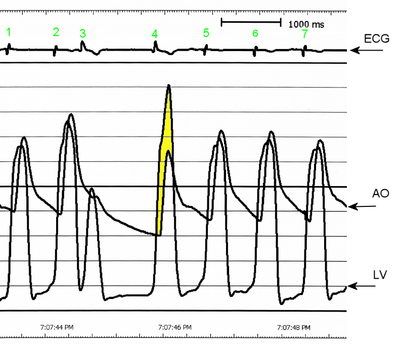Definition
Cardiomyopathy is an ongoing disease process that damages the muscle wall of the lower chambers of the heart. Hypertrophic cardiomyopathy is a form of cardiomyopathy in which the walls of the heart's chambers thicken abnormally. Other names for hypertrophic cardiomyopathy are idiopathic hypertrophic subaortic stenosis and asymmetrical septal hypertrophy.
Description
Hypertrophic cardiomyopathy usually appears in young people, often in athletes. For this reason it is sometimes called athletic heart muscle disease. However, people of any age can develop hypertrophic cardiomyopathy. Often there are no symptoms of hypertrophic cardiomyopathy. Sudden death can occur, caused by a heart arrhythmia. The American Heart Association reports that 36% of young athletes who die suddenly have probable or definite hypertrophic cardiomyopathy.
Hypertrophic cardiomyopathy is the result of abnormal growth of the heart muscle cells. The wall between the heart's chambers (the septum) may become so thickened that it blocks the flow of blood through the lower left chamber (left ventricle). The thickened wall may push on the heart valve between the two left heart chambers (mitral valve), making it leaky. The thickened muscle walls also prevent the heart from stretching as much as it should to fill with blood.
Causes & symptoms
The cause of hypertrophic cardiomyopathy is not known. In about one-half of cases, the disease is inherited. An abnormal gene has been identified in these patients. In cases that are not hereditary, a gene that was normal at birth may later become abnormal.
Often people with hypertrophic cardiomyopathy have no symptoms. Unfortunately, the first sign of the condition may be sudden death caused by an abnormal heart rhythm. When symptoms do appear, they include shortness of breath on exertion, dizziness, fainting, fatigue, and chest pain.
Diagnosis
The diagnosis is based on the patient's symptoms (if any), a complete physical examination, and tests that detect abnormalities of the heart chambers. Usually, there is an abnormal heart murmur that worsens with the Valsalva maneuver. The electrocardiogram (ECG), which provides a record of electrical changes in the heart muscle during the heartbeat, also is typically abnormal.
Sometimes, a routine chest x ray may show that the heart is enlarged. Echocardiography, a procedure that produces images of the heart's structure, is usually done. These images can show if the heart wall is thickened and if there are any abnormalities of the heart valves.
Treatment
Treatment of hypertrophic cardiomyopathy usually consists of taking medicines and restricting strenuous exercise. Drugs called beta blockers and calcium channel blockers are usually prescribed. Beta blockers reduce the force of the heart's contractions. Calcium channel blockers can help improve the flexibility of the heart muscle walls, allowing them to stretch more. Antiarrhythmic drugs may also be given to prevent abnormal heart rhythms.
Patients with hypertrophic cardiomyopathy are also told to avoid strenuous exercise to reduce the risk of passing out or sudden death.
In some cases, if the medications do not help relieve symptoms, surgery may help. In an operation called myotomy-myectomy a piece of the septum is removed to improve blood flow through the heart chamber.
Some patients have pacemakers and/or defibrillators implanted to help control the heart rate and rhythm. Pacemakers and defibrillators provide electrical impulses to the heart, which can return the heart beat to a normal rhythm.
If these treatment methods fail and a patient develops heart failure, a heart transplant may be necessary.
Prognosis
Some people with hypertrophic cardiomyopathy may not have obstructed blood flow and may never experience symptoms. Others may only experience mild symptoms. With treatment, symptoms may improve. In some patients, the disease may progress to heart failure.
Prevention
While hypertrophic cardiomyopathy cannot be prevented, precautionary measures may prevent sudden deaths. Anyone planning to take part in a program of strenuous competitive exercise should have a check up by a physician first. A physical examination before athletic participation can usually, but not always, detect conditions like hypertrophic cardiomyopathy. Anyone who experiences symptoms of shortness of breath, tiredness, or fainting with exercise should see a physician.
Key Terms
- Arrhythmias
- Abnormal heartbeat.
- Calcium channel blocker
- A drug that relaxes blood vessels and lowers blood pressure.
- Mitral valve
- The heart valve that controls blood flow between the heart's left upper chamber (atrium) and left lower chamber (ventricle).
- Septum
- The muscular wall dividing the left and right heart chambers.
- Ventricles
- The two lower chambers of the heart.
Further Reading
For Your Information
Books
- Bellenir, Karen and Peter D. Dresser, editors. Cardiovascular Diseases and Disorders Sourcebook. Detroit: Omnigraphics, 1995.
- Texas Heart Institute. Heart Owner's Handbook. New York: John Wiley and Sons, 1996.
Organizations
- American Heart Association. 7272 Greenview Avenue, Dallas, TX 75231-4596. (800) AHS-USA1. http://www.amhrt.org/.
- National Heart, Lung, and Blood Institute. Information Center, PO Box 30105, Bethesda, MD 20824-0105. (301) 251-1222.
- Texas Heart Institute. Heart Information Service, PO Box 20345, Houston, TX 77225-0345. (800) 292-2221.
Gale Encyclopedia of Medicine. Gale Research, 1999.



